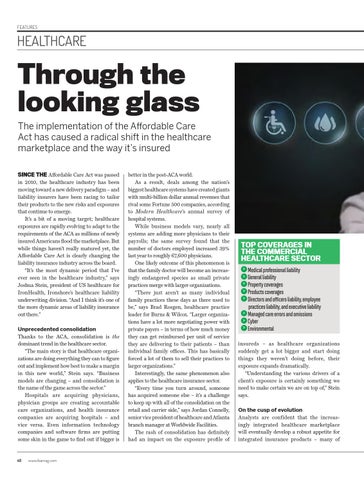FEATURES
HEALTHCARE
Through the looking glass The implementation of the Affordable Care Act has caused a radical shift in the healthcare marketplace and the way it’s insured SINCE THE Affordable Care Act was passed in 2010, the healthcare industry has been moving toward a new delivery paradigm – and liability insurers have been racing to tailor their products to the new risks and exposures that continue to emerge. It’s a bit of a moving target; healthcare exposures are rapidly evolving to adapt to the requirements of the ACA as millions of newly insured Americans flood the marketplace. But while things haven’t really matured yet, the Affordable Care Act is clearly changing the liability insurance industry across the board. “It’s the most dynamic period that I’ve ever seen in the healthcare industry,” says Joshua Stein, president of US healthcare for IronHealth, Ironshore’s healthcare liability underwriting division. “And I think it’s one of the more dynamic areas of liability insurance out there.”
Unprecedented consolidation Thanks to the ACA, consolidation is the dominant trend in the healthcare sector. “The main story is that healthcare organizations are doing everything they can to figure out and implement how best to make a margin in this new world,” Stein says. “Business models are changing – and consolidation is the name of the game across the sector.” Hospitals are acquiring physicians, physician groups are creating accountable care organizations, and health insurance companies are acquiring hospitals – and vice versa. Even information technology companies and software firms are putting some skin in the game to find out if bigger is
48
better in the post-ACA world. As a result, deals among the nation’s biggest healthcare systems have created giants with multi-billion dollar annual revenues that rival some Fortune 500 companies, according to Modern Healthcare’s annual survey of hospital systems. While business models vary, nearly all systems are adding more physicians to their payrolls; the same survey found that the number of doctors employed increased 39% last year to roughly 67,600 physicians. One likely outcome of this phenomenon is that the family doctor will become an increasingly endangered species as small private practices merge with larger organizations. “There just aren’t as many individual family practices these days as there used to be,” says Brad Rosgen, healthcare practice leader for Burns & Wilcox. “Larger organizations have a lot more negotiating power with private payers – in terms of how much money they can get reimbursed per unit of service they are delivering to their patients – than individual family offices. This has basically forced a lot of them to sell their practices to larger organizations.” Interestingly, the same phenomenon also applies to the healthcare insurance sector. “Every time you turn around, someone has acquired someone else – it’s a challenge to keep up with all of the consolidation on the retail and carrier side,” says Jordan Connelly, senior vice president of healthcare and Atlanta branch manager at Worldwide Facilities. The rash of consolidation has definitely had an impact on the exposure profile of
TOP COVERAGES IN THE COMMERCIAL HEALTHCARE SECTOR > > > > >
Medical professional liability General liability Property coverages Products coverages Directors and officers liability, employee practices liability, and executive liability > Managed care errors and omissions > Cyber > Environmental insureds – as healthcare organizations suddenly get a lot bigger and start doing things they weren’t doing before, their exposure expands dramatically. “Understanding the various drivers of a client’s exposure is certainly something we need to make certain we are on top of,” Stein says.
On the cusp of evolution Analysts are confident that the increasingly integrated healthcare marketplace will eventually develop a robust appetite for integrated insurance products – many of
www.ibamag.com
48-51_Ad Led Health Care-SUBBED 2.indd 48
18/09/2015 5:29:11 AM
